Foliar Application of Macro- and Micronutrients Improves the Productivity, Economic Returns, and Resource-Use Efficiency of Soybean in a Semiarid Climate
Abstract
1. Introduction
2. Material and Methods
2.1. Study Site and Weather Condition
2.2. Experimental Design and Crop Management
2.3. Data Collection
2.3.1. Growth Contributing Parameters
2.3.2. Photosynthetically Active Radiation (PAR), Normalized Difference Vegetation Index (NDVI), and Chlorophyll Content
2.3.3. Crop Growth Rate and Relative Growth Rate
2.3.4. Yield Contribution Parameters
2.3.5. Seed and Stover Yields and Harvest Index
2.3.6. Resource-Use Efficiencies
2.4. Statistical Analyses
3. Results
3.1. Plant Height, Branches per Plant, Leaf Area Index, and Dry Matter Accumulation
3.2. Photosynthetically Active Radiation (PAR), Normalized Difference Vegetation Index (NDVI), and Chlorophyll Content
3.3. Crop Growth Rate and Relative Growth Rate
3.4. Yield Attribute-Pods/Plant, Seeds/Pod, and Seed Index
3.5. Yield
3.6. Economic Budgeting
3.7. Water-Use Efficiency and Production Efficiency
4. Discussion
5. Conclusions
- Soybean treated with Zn0.5%, B0.5%, NPK2%, and urea2% recorded 18–37, 16–23, and 14–23% higher grain yields over control treatment (NFN).
- Net returns from crops sprayed with chelated Zn0.5%, NPK2%, urea2%, and DAP2% were greater by 21–58%, 15–17%, 8–30%, and 25–63%, respectively over those from NFN treatment.
- Foliar application of Zn0.5% increases WUE by 29.5% over NFN treatment. Similarly, a spray of Mo0.5% enhanced WUE by 16.8–28.1% over NFN treatment.
- Foliar nutrition of Zn at 0.5% spray, followed by 2% urea, 2% NPK (19:19:19 fertilizer), and 2% DAP resulted in significantly higher yield (1563–2372 kgha−1), net returns (USD 596.8–720.4 ha−1), ME (USD 9.05–9.93 ha−1day−1), and PE (14.3–20.1 kg grain ha−1day−1).
Author Contributions
Funding
Institutional Review Board Statement
Informed Consent Statement
Data Availability Statement
Acknowledgments
Conflicts of Interest
References
- Choudhary, A.; Rana, D.; Bana, R.; Pooniya, V.; Dass, A.; Kaur, R.; Rana, K. Agronomy of Oilseed and Pulse Crops; PG School, IARI: New Delhi, India; ICAR, DARE: New Delhi, India, 2015. [Google Scholar]
- Das, A.; Babu, S.; Yadav, G.S.; Ansari, M.A.; Singh, R.; Baishya, L.K.; Rajkhowa, D.J.; Ngachan, S.V. Status and strategies for pulses production for food and nutritional security in North-Eastern Region of India. Indian J. Agron. 2016, 61, 43–47. [Google Scholar]
- Dass, A.; Bhattacharyya, R. Wheat residue mulch and anti-transpirants improve productivity and quality of rainfed soybean in semi-arid north-indian plains. Field Crop. Res. 2017, 210, 9–19. [Google Scholar] [CrossRef]
- Keyser, H.H.; Li, F. Potential for increasing biological nitrogen fixation in soybean. Plant Soil 1992, 141, 119–135. [Google Scholar] [CrossRef]
- Dass, A. Response of Gram Varieties to Sowing Dates and Phosphorus under on-Farm Conditions; CSKHPKV: Palampur, India, 1996. [Google Scholar]
- Kobraee, S.; Noor Mohamadi, G.; HeidariSharifAbad, H.; DarvishKajori, F.; Delkhosh, B. Micronutrients distribution in soybean plant with Zn, Fe, and Mn application. Annu. Res. Rev. Biol. 2013, 2, 83–91. [Google Scholar]
- Alam, S.; Kamei, S.; Kawai, S. Amelioration of manganese toxicity in barley with iron. J. Plant Nutr. 2001, 24, 1421–1433. [Google Scholar] [CrossRef]
- Alloway, B.J. Zinc in Soils and Crop Nutrition; International Fertilizer Industry Association and International Zinc Association: Brussels, Belgium; Paris, France, 2004; p. 135. [Google Scholar]
- Ghasemian, V.; Ghalavand, A.; Zadeh, A.S.; Pirzad, A. The effect of iron, zinc and manganese on quality and quantity of soybean seed. J. Phytol. 2010, 2, 73–79. [Google Scholar]
- Hasanuzzaman, M.; Bhuyan, M.H.M.B.; Nahar, K.; Hossain, M.S.; Mahmud, J.A.; Hossen, M.S.; Masud, A.A.C.; Moumita; Fujita, M. Potassium: A vital regulator of plant responses and tolerance to abiotic stresses. Agronomy 2018, 8, 31. [Google Scholar] [CrossRef]
- Yadav, G.S.; Das, A.; Kandpal, B.K.; Babu, S.; Lal, R.; Datta, M.; Das, B.; Singh, R.; Singh, V.K.; Mohapatra, K.P.; et al. The food-energy-water-carbon nexus in a maize-maize-mustard cropping sequence of the Indian Himalayas: An impact of tillage-cum-live mulching. Renew. Sustain. Energy Rev. 2021, 151, 111602. [Google Scholar] [CrossRef]
- Yadav, G.S.; Babu, S.; Das, A.; Mohapatra, K.P.; Singh, R.; Avasthe, R.K.; Roy, S. No till and mulching enhance energy use efficiency and reduce carbon footprint of a direct-seeded upland rice production system. J. Clean. Prod. 2020, 271, 122700. [Google Scholar] [CrossRef]
- Babu, S.; Singh, R.; Yadav, D.; Rathore, S.S.; Raj, R.; Avasthe, R.; Yadav, S.K.; Das, A.; Yadav, V.; Yadav, B.; et al. Nanofertilizers for agricultural and environmental sustainability. Chemosphere 2022, 292, 133451. [Google Scholar] [CrossRef]
- Fageria, N. Soil fertility and plant nutrition research under field conditions: Basic principles and methodology. J. Plant Nutr. 2007, 30, 203–223. [Google Scholar] [CrossRef]
- Cakmak, I. Enrichment of cereal grains with zinc: Agronomic or genetic biofortification? Plant Soil 2008, 302, 1–17. [Google Scholar] [CrossRef]
- Baybordi, A. Zinc in Soils and Crop Nutrition; Parivar Press: Tehran, Iran, 2006; p. 179. [Google Scholar]
- Fageria, N. Calcium. In The Use of Nutrıents in Crop Plants; CRC Press: Boca Raton, FL, USA, 2009. [Google Scholar]
- Fox, T.C.; Guerinot, M.L. Molecular biology of cation transport in plants. Annu. Rev. Plant Physiol. Plant Mol. Biol. 1998, 49, 669–696. [Google Scholar] [CrossRef]
- Bennett, E.J.; Roberts, J.A.; Wagstaff, C. The role of the pod in seed development: Strategies for manipulating yield. New Phytol. 2011, 190, 838–853. [Google Scholar] [CrossRef] [PubMed]
- Zolfaghari Gheshlaghi, M.; Pasari, B.; Shams, K.; Rokhzadi, A.; Mohammadi, K. The effect of micronutrient foliar application on yield, seed quality and some biochemical traits of soybean cultivars under drought stress. J. Plant Nutr. 2019, 42, 2715–2730. [Google Scholar] [CrossRef]
- Nelson, K.A.; Motavalli, P.P.; Stevens, W.E.; Kendig, J.A.; Dunn, D.; Nathan, M. Foliar potassium fertilizer additives affect soybean response and weed control with glyphosate. Int. J. Agron. 2012, 2012, 461894. [Google Scholar] [CrossRef][Green Version]
- Egli, D.B. Seed-fill duration and yield of grain crops. Adv. Agron. 2004, 83, 243–279. [Google Scholar]
- Waters, B.M.; Sankaran, R.P. Moving micronutrients from the soil to the seeds: Genes and physiological processes from a biofortification perspective. Plant Sci. 2011, 180, 562–574. [Google Scholar] [CrossRef]
- Hacisalihoglu, G.; Ozturk, L.; Cakmak, I.; Welch, R.M.; Kochian, L. Genotypic variation in common bean in response to zinc deficiency in calcareous soil. Plant Soil 2004, 259, 71–83. [Google Scholar] [CrossRef]
- Paschke, M.W.; Valdecantos, A.; Redente, E.F. Manganese toxicity thresholds for restoration grass species. Environ. Pollut. 2005, 135, 313–322. [Google Scholar] [CrossRef]
- Pathak, G.C.; Gupta, B.; Pandey, N. Improving reproductive efficiency of chickpea by foliar application of zinc. Braz. J. Plant Physiol. 2012, 24, 173–180. [Google Scholar] [CrossRef]
- Moraghan, J.; Padilla, J.; Etchevers, J.; Grafton, K.; Acosta-Gallegos, J. Iron accumulation in seed of common bean. Plant Soil 2002, 246, 175–183. [Google Scholar] [CrossRef]
- Yadav, S.K.; Babu, S.; Singh, Y.; Yadav, G.S.; Singh, K.; Singh, R.; Singh, H. Effect of organic nitrogen sources and biofertilizers on production potential and energy budgeting of rice (Oryza sativa)-based cropping systems. Indian J. Agron. 2013, 58, 459–464. [Google Scholar]
- Zocchi, G.; De Nisi, P.; Dell’Orto, M.; Espen, L.; Gallina, P.M. Iron deficiency differently affects metabolic responses in soybean roots. J. Exp. Bot. 2007, 58, 993–1000. [Google Scholar] [CrossRef] [PubMed]
- Kobraee, S.; Shamsi, K. Impact of micronutrients foliar application on soybean yield and its components under water deficit condition. J. Biodivers. Environ. Sci. 2013, 3, 39–45. [Google Scholar]
- Kavita, K.; Anchal, D.; Sudhishri, S.; Ramanjit, K.; Rajender, K. Effect of irrigation regimes and nitrogen rates on photosynthetically active radiation interception, photosynthetic rate and dry matter partitioning in maize (Zea mays). Indian J. Agric. Sci. 2017, 87, 1575–1578. [Google Scholar]
- GR, H.; Giri, S.; Yelvikar, N. Effect of foliar application of micronutrients on nutrient uptake by soybean crop. Int. J. Pure App. Biosci. 2018, 6, 261–265. [Google Scholar]
- Association, I.F.I. Fertilizers and Their Use: A Pocket Guide for Extension Officers; Food & Agriculture Org: Rome, Italy, 2000. [Google Scholar]
- Panwar, A.S.; Shamim, M.; Babu, S.; Ravishankar, N.; Prusty, A.K.; Alam, N.M.; Singh, D.K.; Bindhu, J.S.; Kaur, J.; Dashora, L.N.; et al. Enhancement in productivity, nutrients use efficiency and economics of rice-wheat cropping systems in India through farmer’s participatory approach. Sustainability 2019, 11, 122. [Google Scholar] [CrossRef]
- Rathore, S.S.; Babu, S.; Shekhawat, K.; Singh, R.; Yadav, S.K.; Singh, V.K.; Singh, C. Designing energy cum carbon-efficient environmentally clean production system for achieving green economy in agriculture. Sustain. Energy Technol. Assess. 2022, 52, 102190. [Google Scholar] [CrossRef]
- Brown, P.H.; Cakmak, I.; Zhang, Q. Form and Function of Zinc Plants. In Zinc in Soils and Plants; Springer: Berlin/Heidelberg, Germany, 1993; pp. 93–106. [Google Scholar]
- Jan, B.; Bhat, T.A.; Sheikh, T.A.; Wani, O.A.; Bhat, M.A.; Nazir, A.; Fayaz, S.; Mushtaq, T.; Farooq, A.; Wani, S. Agronomic bio-fortification of rice and maize with iron and zinc: A review. Int. Res. J. Pure Appl. Chem. 2020, 21, 28–37. [Google Scholar] [CrossRef]
- Kumagai, E.; Takahashi, T. Soybean (Glycine max (L.) Merr.) Yield reduction due to late sowing as a function of radiation interception and use in a cool region of Northern Japan. Agronomy 2020, 10, 66. [Google Scholar] [CrossRef]
- Mansoor, S.; Kour, N.; Manhas, S.; Zahid, S.; Wani, O.A.; Sharma, V.; Wijaya, L.; Alyemeni, M.N.; Alsahli, A.A.; El-Serehy, H.A. Biochar as a tool for effective management of drought and heavy metal toxicity. Chemosphere 2021, 271, 129458. [Google Scholar] [CrossRef] [PubMed]
- Ross, C.; Salisbury, F.B. Plant Physiology, 1947–1972; Missouri Botanical Garden Press: St. Louis, MO, USA, 1974; Volume 61, pp. 112–113. [Google Scholar]
- Dass, A.; Dey, D.; Lal, S.; Rajanna, G. Tank-mix insecticide and herbicide application effects on weeds, insect-pest menace and soybean productivity in semi-arid northern plains of india. Legume Res. 2019, 42, 385–391. [Google Scholar] [CrossRef]
- Mahdi, S.S.; Dhekale, B.S.; Hussain, A.; Jehangir, I.A.; Jan, R.; Bhat, M.A.; Sofi, N.R.; Ahmed, L.; Qureshi, A.M.I.; Aezum, A.M.; et al. Analysis and farmers perception of climate change trends in kashmir region of union territory-Jammu & Kashmir, India: North western himalayas. Res. Sq. 2021. [Google Scholar] [CrossRef]
- Pérez-Vicente, R.; Pineda, M.; Cárdenas, J. Isolation and characterization of xanthine dehydrogenase from Chlamydomonas reinhardtii. Physiol. Plant. 1988, 72, 101–107. [Google Scholar] [CrossRef]
- Walkley, C. An examination of degtjareff method of determining soil organic matter and proposed modification of the method of the chromic acid titration method. Soil Sci. 1934, 37, 29–38. [Google Scholar] [CrossRef]
- Adhikari, B.; Dhungana, S.K.; Kim, I.D.; Shin, D.H. Effect of foliar application of potassium fertilizers on soybean plants under salinity stress. J. Saudi Soc. Agric. Sci. 2020, 19, 261–269. [Google Scholar] [CrossRef]
- Boote, K.; Gallaher, R.; Robertson, W.; Hinson, K.; Hammond, L. Effect of foliar fertilization on photosynthesis, leaf nutrition, and yield of soybeans. Agron. J. 1978, 70, 787–791. [Google Scholar] [CrossRef]
- Kulhare, P.; Chaudhary, M.; Uike, Y.; Sharma, G.; Thakur, R. Direct and residual effect of Zn alone and incubated with cow dung on growth characters, zn content, uptake and quality of soybean [Glycine max (L.) merrill]–wheat (Triticum aestivum L.) in a vertisol. Soybean Res. 2014, 12, 63–74. [Google Scholar]
- Guertal, E.; Abaye, A.; Lippert, B.; Miner, G.; Gascho, G. 1996. Sources of boron for foliar fertilization of cotton and soybean. Commun Soil Sci. Plant Anal. 1996, 27, 15–17. [Google Scholar] [CrossRef]
- Kaya, C.; Higgs, D. Response of tomato (Lycopersicon esculentum L.) cultivars to foliar application of zinc when grown in sand culture at low zinc. Sci. Hortic. 2002, 93, 53–64. [Google Scholar] [CrossRef]
- Pandey, N.; Pathak, G.C.; Sharma, C.P. Zinc is critically required for pollen function and fertilisation in lentil. J. Trace. Elem. Med. Biol. 2006, 20, 89–96. [Google Scholar] [CrossRef] [PubMed]
- Yadav, G.S.; Shivay, Y.S.; Kumar, D.; Babu, S. Enhancing iron density and uptake in grain and straw of aerobic rice through mulching and rhizo-foliar fertilization of iron. Afr. J. Agric. Res. 2013, 8, 5447–5454. [Google Scholar]
- Daraz Khan, G.; Latif, M.; Hassan, S. The role of controlled drainage under drought conditions in an irrigated area in NWFP, Pakistan. Irrig. Drain. 2003, 52, 147–162. [Google Scholar] [CrossRef]
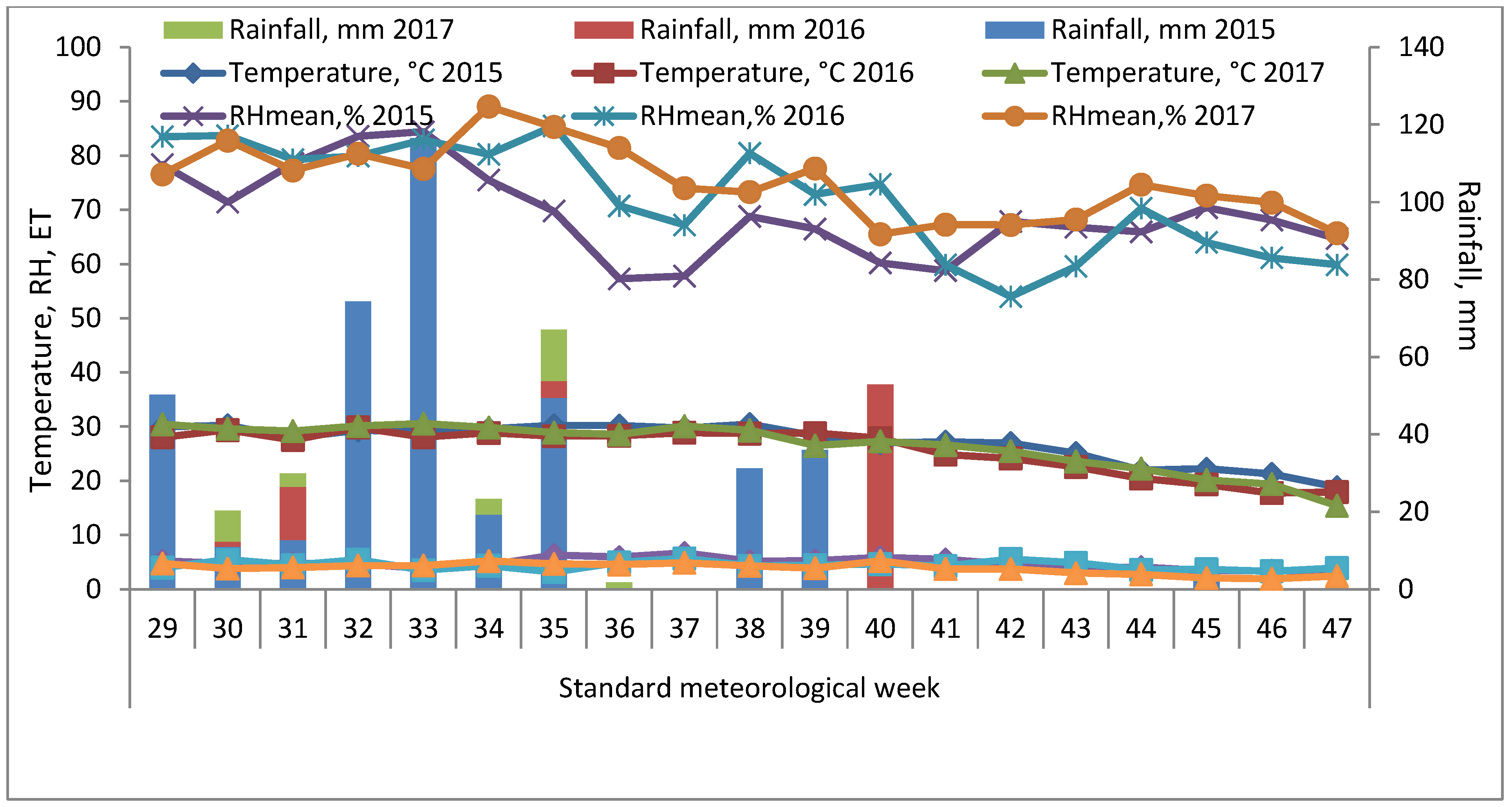
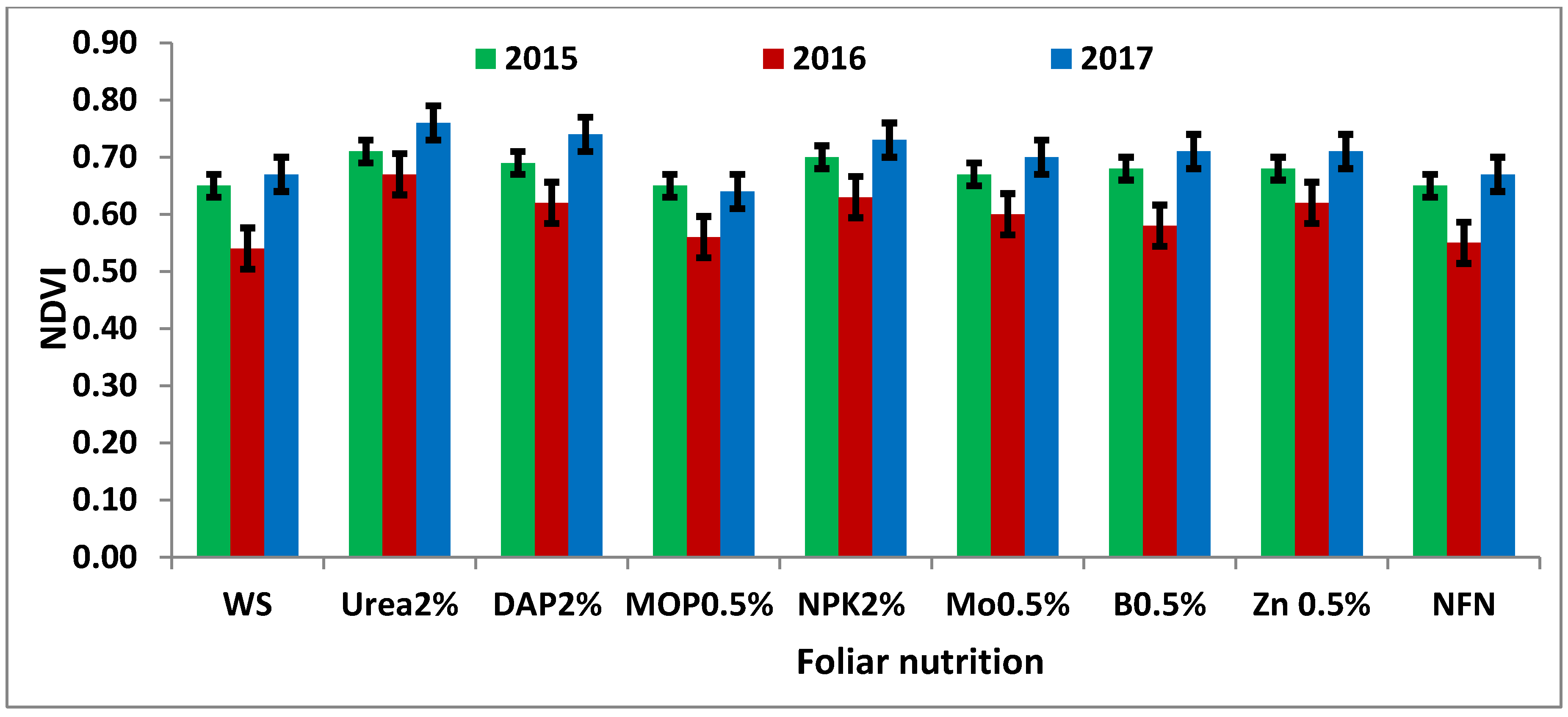
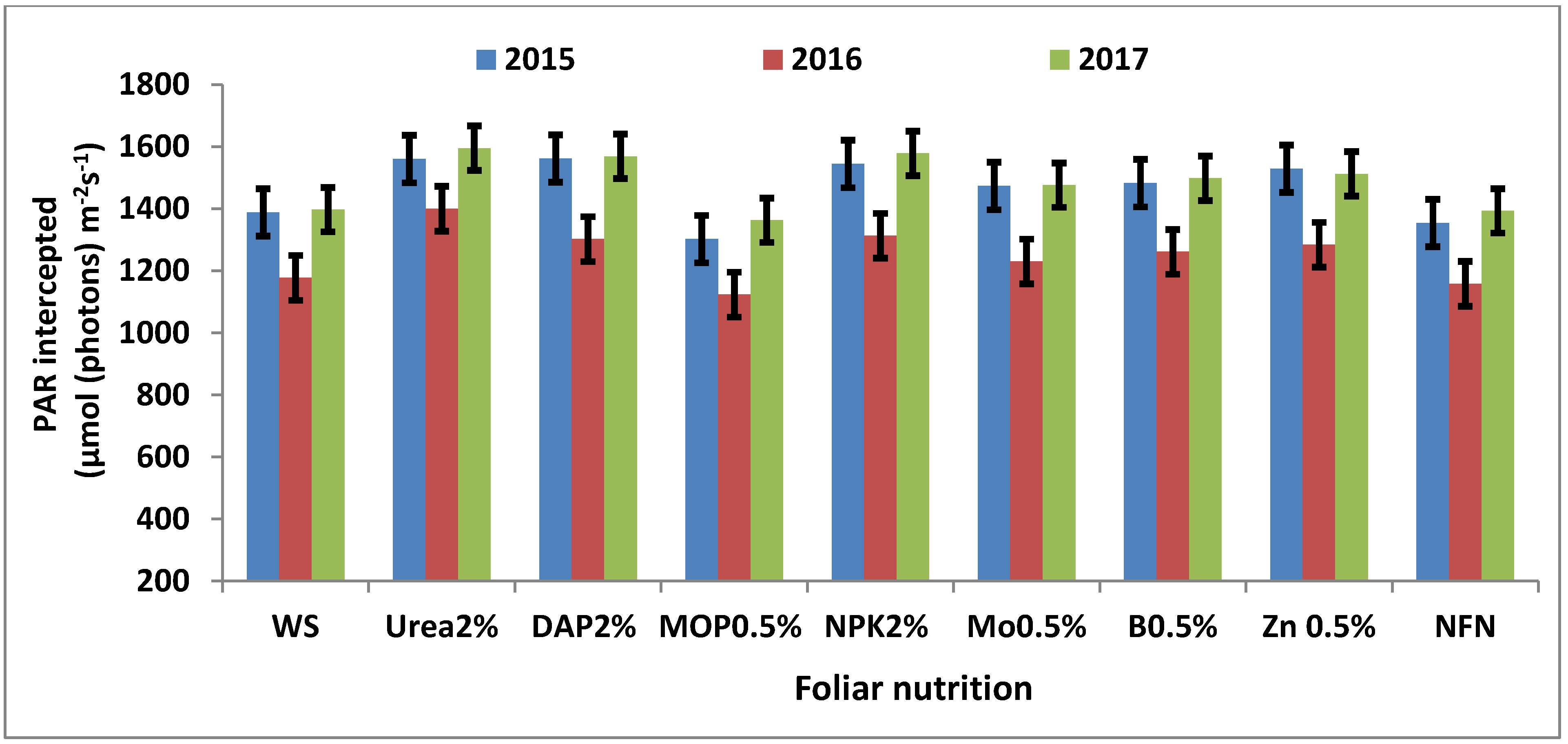
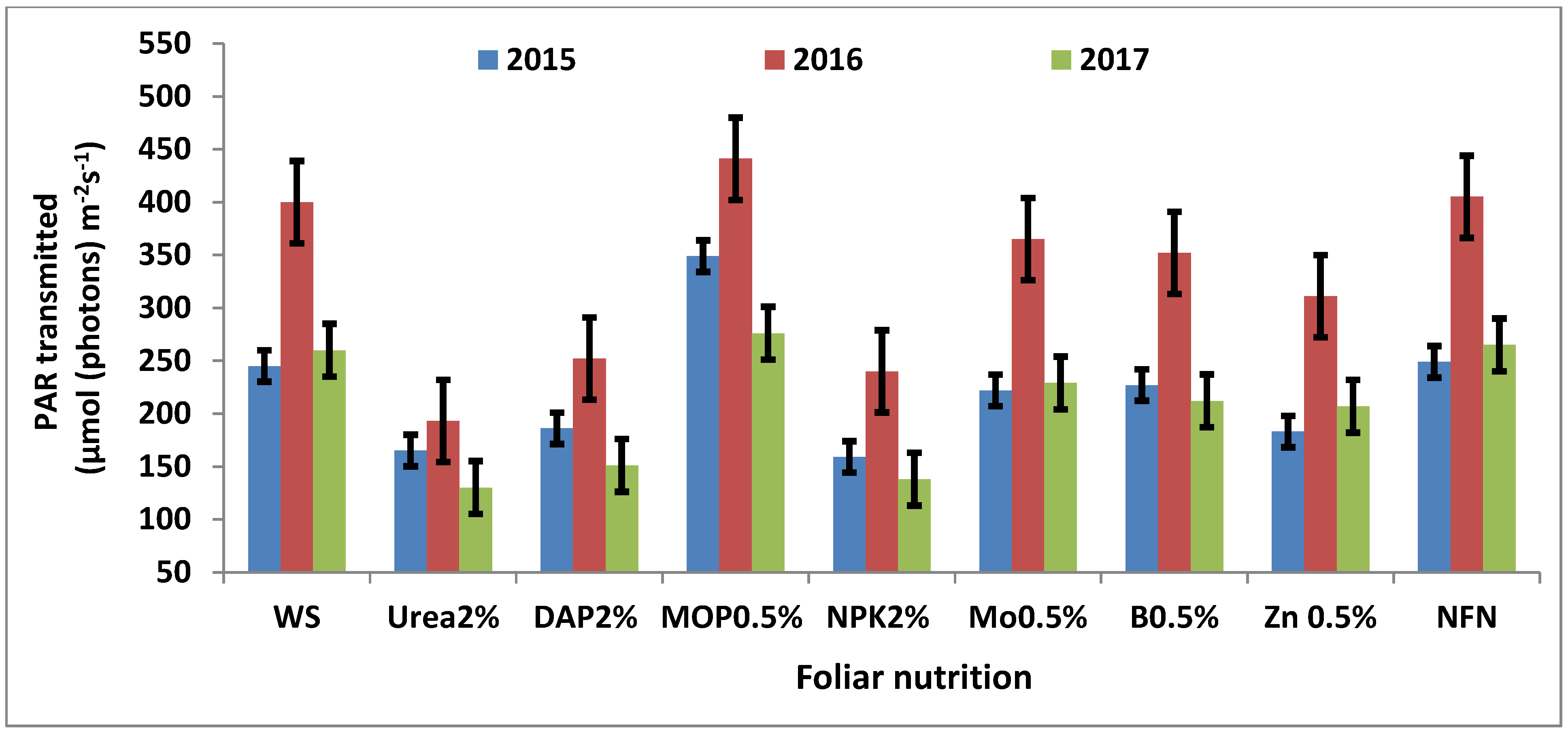

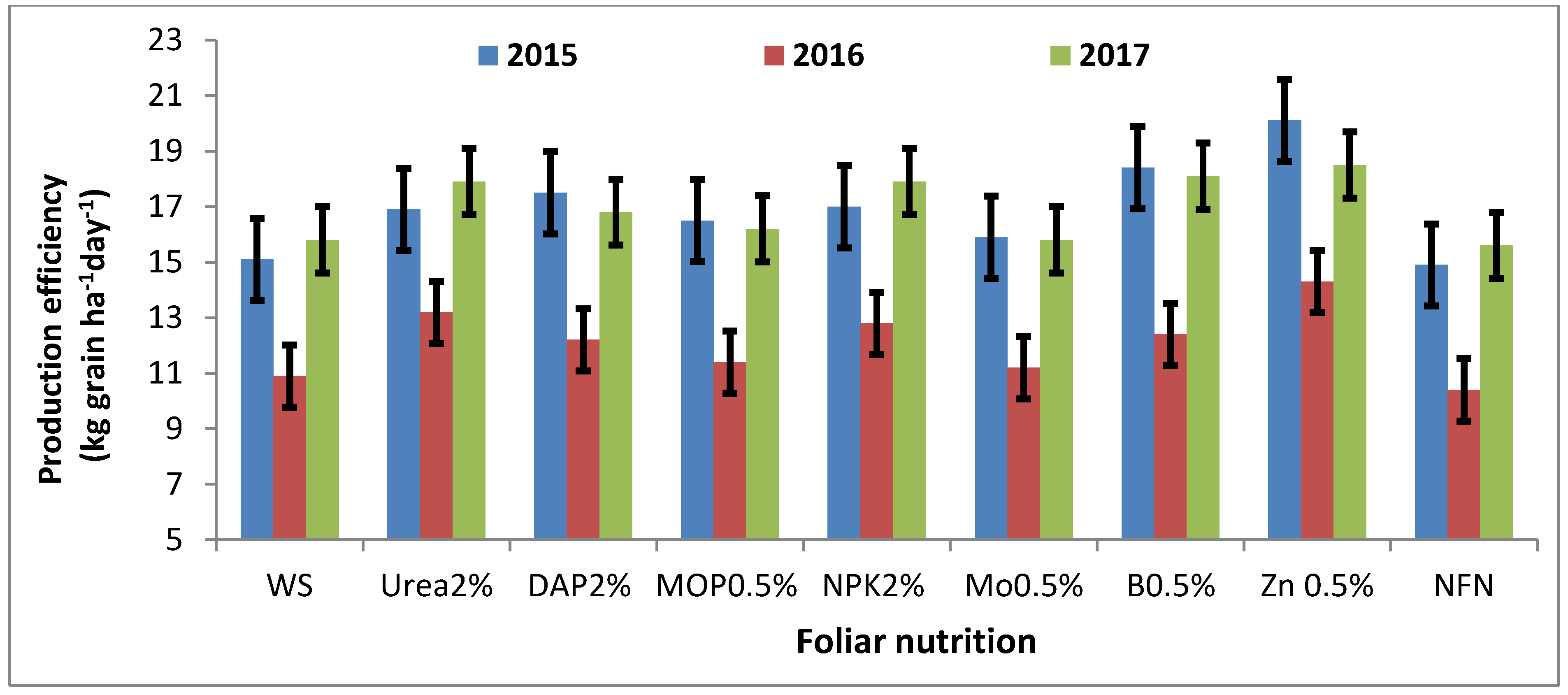
| Properties | Average Value | ||
|---|---|---|---|
| 2015 | 2016 | 2017 | |
| Oxidizable organic C (g kg−1) | 4.7 | 4.9 | 4.8 |
| Available nitrogen | 195 | 190 | 194 |
| Available P2O5 kg ha−1 | 27.6 | 26.2 | 25.7 |
| Available K2O kg ha−1 | 309 | 280 | 288 |
| Soil pH | 7.4 | 7.3 | 7.3 |
| Available Zn (mg kg−1) | 0.66 | 0.65 | 0.65 |
| Treatment | Plant Height (cm) | Branches/Plant | Dry Matter Accumulation (g/Plant) | Leaf Area Index | SPAD Values | ||||||||||
|---|---|---|---|---|---|---|---|---|---|---|---|---|---|---|---|
| 2015 | 2016 | 2017 | 2015 | 2016 | 2017 | 2015 | 2016 | 2017 | 2015 | 2016 | 2017 | 2015 | 2016 | 2017 | |
| WS | 54.0 | 51.5 | 66.6 | 5.5 | 5.2 | 5.7 | 15.9 | 13.4 | 16.2 | 3.2 | 2.7 | 3.2 | 37.9 | 37.6 | 38.1 |
| Urea2% | 60.7 | 57.1 | 74.3 | 5.7 | 5.4 | 6.2 | 17.4 | 15.3 | 18.2 | 3.5 | 3.4 | 3.6 | 42.2 | 41.7 | 42.6 |
| DAP2% | 59.5 | 56.4 | 72.8 | 5.6 | 5.1 | 6.0 | 17.1 | 14.8 | 17.4 | 3.4 | 3.3 | 3.5 | 41.6 | 40.1 | 41.4 |
| MOP0.5% | 53.1 | 47.9 | 65.4 | 5.8 | 5.5 | 5.9 | 15.7 | 13.2 | 16.5 | 3.0 | 2.7 | 3.1 | 36.9 | 35.6 | 37.2 |
| NPK2% | 60.1 | 56.8 | 73.6 | 6.0 | 5.7 | 6.1 | 17.4 | 14.0 | 17.9 | 3.4 | 3.1 | 3.5 | 41.0 | 39.7 | 41.4 |
| Mo0.5% | 56.2 | 54.3 | 70.5 | 5.6 | 5.3 | 5.9 | 16.5 | 14.4 | 17.0 | 3.3 | 3.1 | 3.4 | 38.5 | 38.9 | 39.2 |
| B0.5% | 57.6 | 53.9 | 69.2 | 5.6 | 5.5 | 5.9 | 17.1 | 14.1 | 17.4 | 3.3 | 3.1 | 3.4 | 38.8 | 37.8 | 39.6 |
| Zn 0.5% | 58.4 | 55.1 | 72.1 | 5.8 | 5.5 | 6.1 | 17.9 | 14.6 | 18.0 | 3.4 | 3.2 | 3.5 | 39.9 | 39.0 | 40.0 |
| NFN | 54.2 | 51.1 | 66.4 | 5.4 | 5.3 | 5.8 | 15.8 | 13.4 | 16.2 | 3.1 | 2.8 | 3.2 | 37.6 | 37.5 | 38.0 |
| SEm ± | 1.76 | 1.72 | 2.06 | 0.44 | 0.34 | 0.37 | 0.50 | 0.43 | 0.61 | 0.10 | 0.11 | 0.09 | 1.12 | 1.11 | 1.13 |
| CD (p < 0.05) | 5.26 | 5.16 | 6.18 | NS | NS | NS | 1.50 | 1.28 | 1.83 | 0.29 | 0.33 | 0.27 | 3.39 | 3.33 | 3.40 |
| Treatment | CGR | RGR | ||||||||||
|---|---|---|---|---|---|---|---|---|---|---|---|---|
| 45–60 DAS | 60–75 DAS | 45–60 DAS | 60–75 DAS | |||||||||
| 2015 | 2016 | 2017 | 2015 | 2016 | 2017 | 2015 | 2016 | 2017 | 2015 | 2016 | 2017 | |
| WS | 12.4 | 10.5 | 13.1 | 8.4 | 6.6 | 8.1 | 0.041 | 0.040 | 0.042 | 0.018 | 0.017 | 0.017 |
| Urea2% | 12.4 | 11.2 | 14.4 | 11.5 | 9.4 | 10.3 | 0.041 | 0.041 | 0.044 | 0.024 | 0.022 | 0.020 |
| DAP2% | 13.6 | 10. 6 | 13.6 | 9.2 | 9.6 | 9.5 | 0.043 | 0.040 | 0.042 | 0.019 | 0.023 | 0.019 |
| MOP0.5% | 13.3 | 10.2 | 13.5 | 6.3 | 6.1 | 8.0 | 0.042 | 0.039 | 0.042 | 0.013 | 0.016 | 0.016 |
| NPK2% | 13.9 | 11.1 | 14.9 | 9.7 | 7.3 | 9.8 | 0.044 | 0.042 | 0.046 | 0.020 | 0.018 | 0.019 |
| Mo0.5% | 13.1 | 11.8 | 14.1 | 8.9 | 7.8 | 8.8 | 0.043 | 0.044 | 0.045 | 0.019 | 0.018 | 0.018 |
| B0.5% | 13.4 | 10.6 | 14.6 | 9.7 | 7.3 | 9.4 | 0.043 | 0.039 | 0.046 | 0.020 | 0.018 | 0.019 |
| Zn 0.5% | 13.7 | 10.5 | 14.1 | 11.0 | 8.7 | 10.2 | 0.043 | 0.038 | 0.043 | 0.022 | 0.021 | 0.020 |
| NFN | 12.5 | 10.8 | 12.8 | 7.7 | 6.7 | 8.2 | 0.041 | 0.042 | 0.041 | 0.017 | 0.017 | 0.017 |
| SEm ± | 1.24 | 1.21 | 0.97 | 0.61 | 0.59 | 0.62 | 0.002 | 0.004 | 0.003 | 0.002 | 0.001 | 0.001 |
| CD (p = 0.05) | NS | NS | NS | 1.83 | 1.77 | 1.86 | NS | NS | NS | 0.005 | 0.004 | 0.003 |
| Treatment | Pods Per Plant | Seed Index | Seed Yield (kg ha−1) | Straw Yield (kg ha−1) | Harvest Index | ||||||||||
|---|---|---|---|---|---|---|---|---|---|---|---|---|---|---|---|
| 2015 | 2016 | 2017 | 2015 | 2016 | 2017 | 2015 | 2016 | 2017 | 2015 | 2016 | 2017 | 2015 | 2016 | 2017 | |
| WS | 38.2 | 31.1 | 40.6 | 9.6 | 9.2 | 10.4 | 1781 | 1187 | 1883 | 4030 | 3581 | 4524 | 0.31 | 0.25 | 0.29 |
| Urea2% | 42.4 | 35.3 | 46.5 | 10.5 | 10.5 | 10.8 | 1994 | 1439 | 2136 | 4376 | 3901 | 4890 | 0.31 | 0.28 | 0.30 |
| DAP2% | 43.5 | 31.2 | 42.7 | 10.6 | 10.1 | 10.7 | 2064 | 1326 | 1998 | 4232 | 3660 | 4669 | 0.33 | 0.27 | 0.30 |
| MOP0.5% | 42.1 | 28.1 | 42.0 | 10.7 | 9.7 | 10.6 | 1947 | 1238 | 1929 | 3942 | 3375 | 4400 | 0.33 | 0.27 | 0.31 |
| NPK2% | 43.4 | 32.1 | 46.3 | 10.8 | 10.3 | 10.9 | 2008 | 1397 | 2136 | 4385 | 3726 | 4693 | 0.31 | 0.27 | 0.31 |
| Mo0.5% | 40.3 | 27.7 | 40.5 | 10.2 | 9.7 | 10.6 | 1881 | 1218 | 1883 | 4007 | 3686 | 4673 | 0.32 | 0.25 | 0.29 |
| B0.5% | 45.5 | 31.8 | 45.2 | 11.0 | 10.2 | 11.2 | 2176 | 1347 | 2159 | 4121 | 3388 | 4397 | 0.35 | 0.29 | 0.33 |
| Zn 0.5% | 48.7 | 38.7 | 47.8 | 11.2 | 11.1 | 11.5 | 2372 | 1563 | 2204 | 4258 | 3459 | 4546 | 0.36 | 0.31 | 0.33 |
| NFN | 38.0 | 27.3 | 40.0 | 9.7 | 9.0 | 10.4 | 1759 | 1134 | 1860 | 3963 | 3574 | 4584 | 0.31 | 0.24 | 0.29 |
| SEm ± | 2.07 | 1.85 | 1.41 | 0.31 | 0.40 | 0.35 | 116.5 | 81.0 | 83.6 | 272 | 319 | 226 | 0.01 | 0.02 | 0.02 |
| CD (p = 0.05) | 6.19 | 5.56 | 4.22 | 0.92 | 1.21 | NS | 349.2 | 242.8 | 250.8 | NS | NS | NS | 0.04 | NS | NS |
| Treatment | Cost of Cultivation (USD ha−1) | Net Returns (USD ha−1) | B:C Ratio | Monetary Efficiency (USD ha−1day−1) | ||||||||
|---|---|---|---|---|---|---|---|---|---|---|---|---|
| 2015 | 2016 | 2017 | 2015 | 2016 | 2017 | 2015 | 2016 | 2017 | 2015 | 2016 | 2017 | |
| WS | 439.0 | 407.1 | 438.9 | 378.7 | 217.3 | 592.7 | 0.86 | 0.53 | 1.35 | 6.99 | 5.79 | 8.67 |
| Urea2% | 441.4 | 409.5 | 441.3 | 470.3 | 332.9 | 720.6 | 1.07 | 0.81 | 1.63 | 7.79 | 6.88 | 9.76 |
| DAP2% | 447.0 | 415.0 | 446.9 | 488.8 | 271.2 | 643.2 | 1.09 | 0.65 | 1.44 | 8.00 | 6.36 | 9.16 |
| MOP0.5% | 440.5 | 408.6 | 440.4 | 440.8 | 230.5 | 608.5 | 1.00 | 0.56 | 1.38 | 7.53 | 5.92 | 8.81 |
| NPK2% | 474.5 | 442.5 | 474.3 | 442.9 | 275.9 | 681.0 | 0.93 | 0.62 | 1.44 | 7.84 | 6.65 | 9.71 |
| Mo0.5% | 672.3 | 640.4 | 672.2 | 184.6 | 0.9 | 364.3 | 0.27 | 0.10 | 0.54 | 7.32 | 5.93 | 8.71 |
| B0.5% | 544.5 | 512.5 | 544.3 | 432.8 | 173.7 | 611.8 | 0.79 | 0.34 | 1.12 | 8.35 | 6.36 | 9.72 |
| Zn 0.5% | 462.3 | 430.4 | 462.2 | 596.8 | 349.8 | 720.4 | 1.29 | 0.81 | 1.56 | 9.05 | 7.23 | 9.93 |
| NFN | 429.9 | 397.9 | 429.3 | 377.2 | 203.8 | 593.5 | 0.88 | 0.51 | 1.38 | 6.89 | 5.57 | 8.60 |
| SEm ± | - | - | - | 51.0 | 36.0 | 42.3 | 0.11 | 0.09 | 0.084 | 0.44 | 0.33 | 0.36 |
| LSD (p = 0.05) | - | - | - | 152.9 | 107.8 | 126.9 | 0.34 | 0.26 | 0.25 | 1.31 | 1.00 | 1.07 |
Publisher’s Note: MDPI stays neutral with regard to jurisdictional claims in published maps and institutional affiliations. |
© 2022 by the authors. Licensee MDPI, Basel, Switzerland. This article is an open access article distributed under the terms and conditions of the Creative Commons Attribution (CC BY) license (https://creativecommons.org/licenses/by/4.0/).
Share and Cite
Dass, A.; Rajanna, G.A.; Babu, S.; Lal, S.K.; Choudhary, A.K.; Singh, R.; Rathore, S.S.; Kaur, R.; Dhar, S.; Singh, T.; et al. Foliar Application of Macro- and Micronutrients Improves the Productivity, Economic Returns, and Resource-Use Efficiency of Soybean in a Semiarid Climate. Sustainability 2022, 14, 5825. https://doi.org/10.3390/su14105825
Dass A, Rajanna GA, Babu S, Lal SK, Choudhary AK, Singh R, Rathore SS, Kaur R, Dhar S, Singh T, et al. Foliar Application of Macro- and Micronutrients Improves the Productivity, Economic Returns, and Resource-Use Efficiency of Soybean in a Semiarid Climate. Sustainability. 2022; 14(10):5825. https://doi.org/10.3390/su14105825
Chicago/Turabian StyleDass, Anchal, Gandhamanagenahalli A. Rajanna, Subhash Babu, Sanjay K. Lal, Anil K. Choudhary, Raj Singh, Sanjay Singh Rathore, Ramanjit Kaur, Shiva Dhar, Teekam Singh, and et al. 2022. "Foliar Application of Macro- and Micronutrients Improves the Productivity, Economic Returns, and Resource-Use Efficiency of Soybean in a Semiarid Climate" Sustainability 14, no. 10: 5825. https://doi.org/10.3390/su14105825
APA StyleDass, A., Rajanna, G. A., Babu, S., Lal, S. K., Choudhary, A. K., Singh, R., Rathore, S. S., Kaur, R., Dhar, S., Singh, T., Raj, R., Shekhawat, K., Singh, C., & Kumar, B. (2022). Foliar Application of Macro- and Micronutrients Improves the Productivity, Economic Returns, and Resource-Use Efficiency of Soybean in a Semiarid Climate. Sustainability, 14(10), 5825. https://doi.org/10.3390/su14105825










